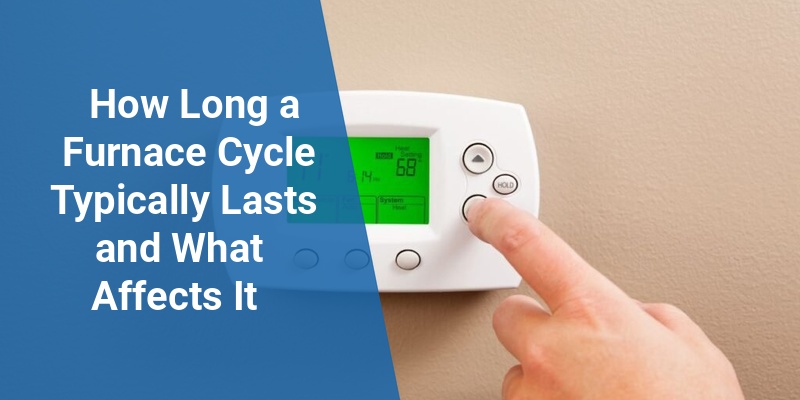A furnace cycle refers to the period during which a furnace turns on to heat a home and then shuts off once the desired temperature is reached. The length of a furnace cycle can vary widely depending on the type of furnace, thermostat settings, home insulation, and outdoor weather conditions. Understanding how long a furnace cycle lasts helps homeowners optimize heating efficiency, extend furnace lifespan, and manage energy costs.
| Factor | Effect on Furnace Cycle Duration |
|---|---|
| Type of Furnace (Gas, Electric, Oil) | Modern furnaces often have shorter, more efficient cycles; older units may run longer. |
| Home Insulation Quality | Better insulation results in longer cycles off, shorter run times while maintaining comfort. |
| Thermostat Settings | Higher or lower set temperatures affect how long the furnace runs to achieve desired warmth. |
| Outdoor Temperature | Colder weather causes longer furnace cycles to maintain indoor temperature. |
What Is a Furnace Cycle?
A furnace cycle consists of the furnace turning on, heating air to raise the indoor temperature, and then turning off once the thermostat’s set temperature is met. This on-off process ensures the home stays comfortable without wasting excessive energy. Each cycle includes a warm-up phase, a steady heating phase, and a cool-down or off phase. Furnace cycles repeat multiple times throughout cold weather periods as needed.
Typical Duration of a Furnace Cycle
On average, a furnace cycle lasts between 10 to 20 minutes, but this duration can fluctuate. Factors that influence this timing include:
- Furnace type: High-efficiency models often have shorter cycles due to rapid heating capabilities.
- Thermostat settings: Aggressive temperature differences (e.g., a large jump from a low nighttime to high daytime setting) will result in longer cycles.
- Home size and insulation: Larger or poorly insulated homes require longer heating cycles to reach temperature.
- Outdoor weather: Extremely cold weather increases furnace runtime to offset heat loss.
Short cycles—under 5 minutes—can indicate system issues like an oversized furnace, causing inefficiency and wear. Long cycles—lasting 30 minutes or more—may suggest poor home insulation or system problems requiring maintenance.
Factors Influencing Furnace Cycle Length
Type of Furnace
The primary types of furnaces in American homes—gas, electric, and oil—operate differently. Modern gas and oil furnaces generally cycle on and off more efficiently than electric furnaces, which tend to run for longer durations. High-efficiency gas furnaces may have shorter, more frequent cycles, reducing energy waste and wear.
Thermostat Settings and Usage
Thermostat programming significantly impacts cycle length. Setting a thermostat to drastic temperature changes between day and night creates longer furnace cycles as the system works harder to reach the desired setting. Using a programmable thermostat can optimize cycle length and reduce energy consumption by maintaining steadier indoor temperatures.
Home Insulation and Air Leakage
Homes with good insulation and sealed air leaks retain heat longer, resulting in shorter furnace run times and longer periods between cycles. Older or poorly insulated homes experience rapid heat loss, demanding longer and more frequent furnace cycles to maintain comfort.
Call 888-906-9139 for Free Local HVAC Quotes – No Obligation, Just Savings!
Outdoor Weather Conditions
Cold temperatures create greater heat loss from a home, which means the furnace must run longer each cycle. Mild weather results in shorter cycles or even periods when heating is unnecessary. Seasonal weather patterns greatly influence how often and how long a furnace operates.
Impact of Furnace Cycle Length on Energy Efficiency
Optimal furnace cycles balance energy use and comfort. Short cycles, known as “short-cycling,” decrease efficiency by repeatedly starting and stopping, increasing wear and energy consumption. Long cycles may seem efficient but can indicate inadequate heat distribution or poor insulation.
- Proper cycle length ensures the furnace runs long enough to heat thoroughly without wasting energy on frequent restarts.
- Regular maintenance, such as filter replacement and duct sealing, can help maintain ideal cycle durations.
Signs Your Furnace Cycle May Be Too Short or Too Long
| Cycle Length | Possible Cause | Potential Solution |
|---|---|---|
| Short Cycles (<5 minutes) | Oversized furnace, thermostat issues, airflow restriction. | Consult HVAC professional for system sizing check and thermostat calibration. |
| Long Cycles (>30 minutes) | Poor insulation, dirty filters, blocked ducts. | Improve home insulation, change air filters, clean ducts. |
How to Monitor and Optimize Furnace Cycles
Homeowners can track furnace cycles by observing how long the furnace runs each time it turns on or using smart thermostats that provide usage data. Optimizing cycles involves setting thermostats to steady temperatures, improving home insulation, and scheduling regular system maintenance.
- Use programmable thermostats to avoid large temperature swings.
- Replace air filters regularly to maintain airflow and prevent strain.
- Seal windows, doors, and ducts to reduce heat loss.
- Schedule annual furnace inspections to address mechanical issues early.
